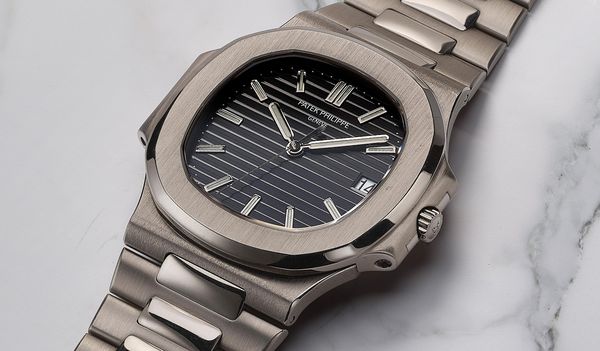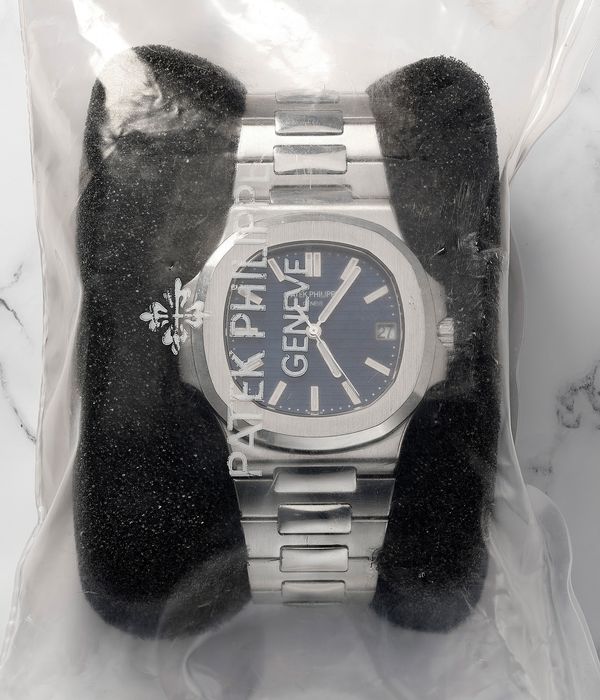The modern era has seen no shortage of anniversaries celebrated, so it feels fitting that we end with one that embodies so much of what has defined the past two decades, and in many ways brings us full circle; heritage influences, sports watches, a celebrated designer, celebrity wearers who become brand ambassadors, the Patek Philippe Nautilus encapsulates so much that has defined the current horological era in an easy to comprehend, if rather difficult to obtain, package.
Hotly anticipated by the collectors’ community, the 40th anniversary of the model in 2016 was known to see the arrival of at least one limited edition, and at Baselworld two new references arrived: the 5711/1P and the 5976/1G. Presented in platinum and white gold respectively with dials adorned with diamond hour markers and the inscription “1976 - 40 - 2016”, they certainly left a sizeable impression on the marketplace, with runs of 700 pieces for the 5711P and 1,300 for the 5976G, replete with cork boxes as an homage to the original packaging 40 years before, quickly allocated.
The watches were interesting for their choice of foundations, the classic time and date reference 5711 that is a direct homage to the original reference 3700 from 1976, and the reference 5980 chronograph date that had been introduced in 2006 for the 30th anniversary, and had become an instant success with a younger demographic. In a way, they are the two references that have come to define the Nautilus: the compact original and the more oversized case format to house complications, with most of the other references acting as sub-divisions from these origins.
It is the story and the models that have led up to this date that make the Nautilus such a fascinating topic for research and understanding. Debuted as one of the most expensive watches in the marketplace, even more amazing when you consider it was made of steel and not gold, the price was driven by the time intensive finishing required to make the case brushed and polished in the right areas, for Gérald Genta’s iconic design to work. The complex construction, with a front loading movement covered by a bezel that sits on a custom made gasket and secured with screws that are perpendicular to its main plane, everywhere you look on a reference 3700 there are details which are carefully considered but difficult to execute.
It was not always an easy sell to clients who had come to expect classical refinement from Patek Philippe, not sporty modernity, but a few markets proved exceptions, like the fashionable Italians. Sales figures improved as small sizes arrived such as the reference 3800, which debuted in 1981 featuring a case diameter of 37.5 mm, down from the 42 mm of the so-called “jumbo” 3700. The fact that the 3800 would have a production run spanning nearly 25 years, while the 3700 was discontinued after approximately 14 is a fairly clear indicator as to which watch was more commercially successful.
History has formed a different narrative though, as is often the case, with the Jumbo now the most coveted reference by far, even with a variety of intervening models before the arrival of the faithful reissues of the 3700 in the shape of the 5711. Models such as the so-called “Comet” reference 3710, with its unusual power reserve indicator, and now highly desirable 3712 that provided the beginnings of the modern hot commodity reference 5712, equipped with a moon-phase and power reserve indication in addition to the date.
The first return of the Jumbo would arrive in 2004, but not quite in the format the market would expect. The reference 3711 had two core details that immediately differentiated it from the reference 3700, that of the white gold case and the black dial. Other changes were more subtle, including a transition to a three part case with screw-down exhibition back and a more modern movement with the calibre 315 SC. The case dimensions stayed true with the 42mm diameter, but the new construction meant thickness increased to 9.4mm, lending a very different presence on the wrist, in addition to the greater mass lent by the use of a precious metal.
The high price tag relating to the white gold construction meant that only a small number would be sold before the 3711 was discontinued in 2006, but it was not a major concern for most enthusiasts as the 30th anniversary of the Nautilus would see the arrival of one of the most sought after references of the modern era: the 5711. Initially offered in stainless steel, with rose gold joining the fray in 2015 for those mounted on bracelets, and a version in yellow gold making a brief appearance fitted with a strap, it would be the version in platinum with an electric blue dial that would become the white whale for the most determined Nautilus collectors.
Never officially appearing in the production catalogue and only offered to the most important clients of Patek Philippe, it would seem that the first examples were delivered in 2013 with only a very small run being completed, perhaps less than 100, before the model would be effectively discontinued when the anniversary 5711P arrived in 2016.
The collective captivation with sports watches has had an outsized impact on the industry since 2000, benefiting brands across the spectrum, but it is the Patek Philippe Nautilus that is perhaps the most complete summary of how important the segment is, providing the introduction to the world of fine watchmaking for so many.


